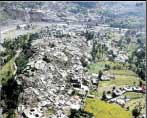The Pakistan Earthquake
By Saif M. Hussain*, SE
Woodland Hills, CA, USA
 The
terrible tragedy of the Kashmir earthquake reminds us of
the peril of ignoring or underplaying the significance of
earthquake hazards and risk. Because major earthquakes in
populated areas occur infrequently and are not predictable,
most people tend to take the "out of sight out of mind"
approach when it comes to managing seismic hazard and risk.
To those of us who are in the earthquake engineering profession
it can be a frustrating exercise to raise the awareness
level of people, especially key decision makers, about the
dire consequences of ignoring or paying inadequate attention
to seismic risk. If this is the case in the Western world,
even in areas like California where I live, then one can
imagine how truly out of mind this issue must be for people
living in Third World countries like Pakistan.
The
terrible tragedy of the Kashmir earthquake reminds us of
the peril of ignoring or underplaying the significance of
earthquake hazards and risk. Because major earthquakes in
populated areas occur infrequently and are not predictable,
most people tend to take the "out of sight out of mind"
approach when it comes to managing seismic hazard and risk.
To those of us who are in the earthquake engineering profession
it can be a frustrating exercise to raise the awareness
level of people, especially key decision makers, about the
dire consequences of ignoring or paying inadequate attention
to seismic risk. If this is the case in the Western world,
even in areas like California where I live, then one can
imagine how truly out of mind this issue must be for people
living in Third World countries like Pakistan.
Most Pakistanis may not even be aware of the high seismic
hazard that exists in most of the country. I grew up in
Karachi never realizing that the seismic hazard exposure
of that region is almost as great as that of Los Angeles!
In fact the Uniform Building Code (UBC) designates Karachi
as Seismic Zone 4, the maximum seismic zonation level and
the same as LA. Most of the Western and northern parts of
Pakistan are at an equal or somewhat higher seismic hazard
level.
When I look back to my first job, after graduating from
the California Institute of Technology, as a Junior Structural
Engineer in Karachi 27 years ago and compare it to my practice
now in LA there is no comparison when it comes to the level
of focus and concentration on seismic hazard mitigation
in the design process. And this is even though one of my
first projects was a large building in Peshawar where seismic
design was supposed to be of major importance. The earthquake
engineering field has undergone tremendous advancement in
the last couple of decades, especially during the last ten
years. Most areas of the world appear to be lagging behind
the western US and Japan when it comes to earthquake hazard
mitigation, though countries like India seem to have made
great strides in this field in the last few years.
A few months ago I contacted the director of an international
nonprofit organization, headquartered in California, that
works in the area of earthquake hazard mitigation in Third
World countries which contain zones of high seismicity.
He informed me that they had successful programs running
in almost every country they had approached, except for
Pakistan where bureaucratic obstacles had made progress
impossible, despite the availability of international funding
sources.
I hope that as a result of this awful earthquake near Muzaffarabad,
concerned government agencies and private parties will adopt
a new, more responsible approach towards the necessary mitigation
of seismic hazard and risk in the country. Because if not
now, then when?
Here is one useful resource for some background information
on seismic hazards in Pakistan:
http://asc-india.org/seismic/pakistan.htm
And this is a great link for real time information on world
wide seismic activity:
http://earthquake.usgs.gov/recenteqsww/Quakes/quakes_all.html
(*President-elect, Structural Engineers Association of Southern
California;
Member: Earthquake Engineering Research Institute;
Managing Principal, Coffman Engineers, Inc., Encino, Ca.
(http://www.coffman.com/))
-------------------------------------------------------------------------------------

